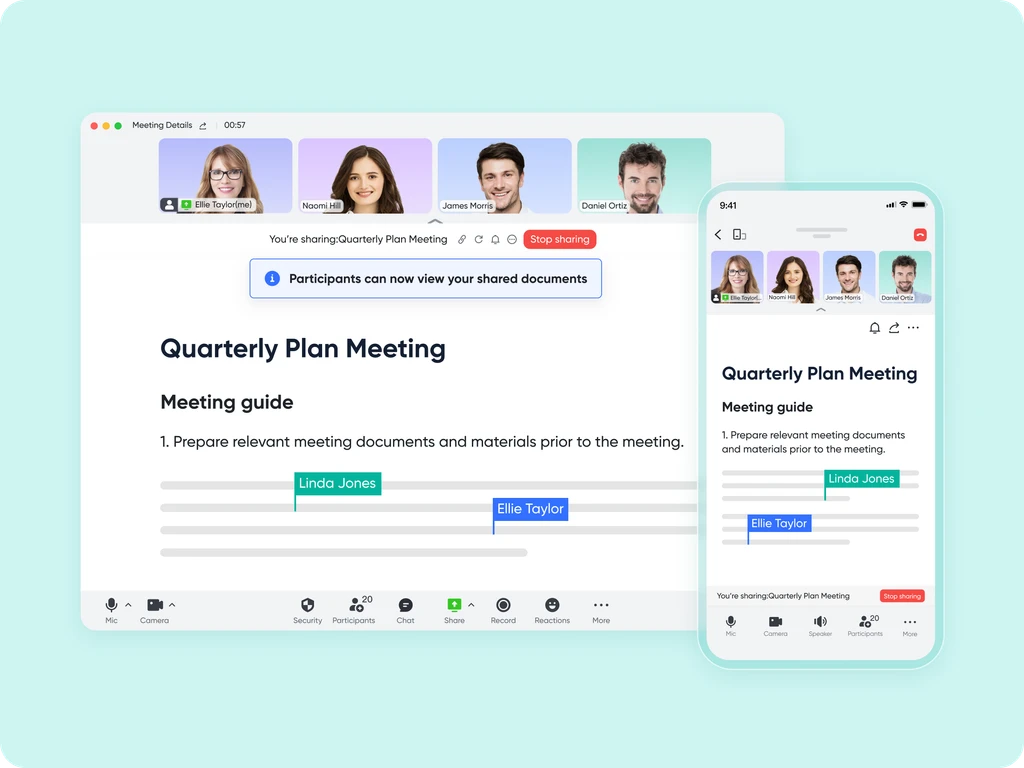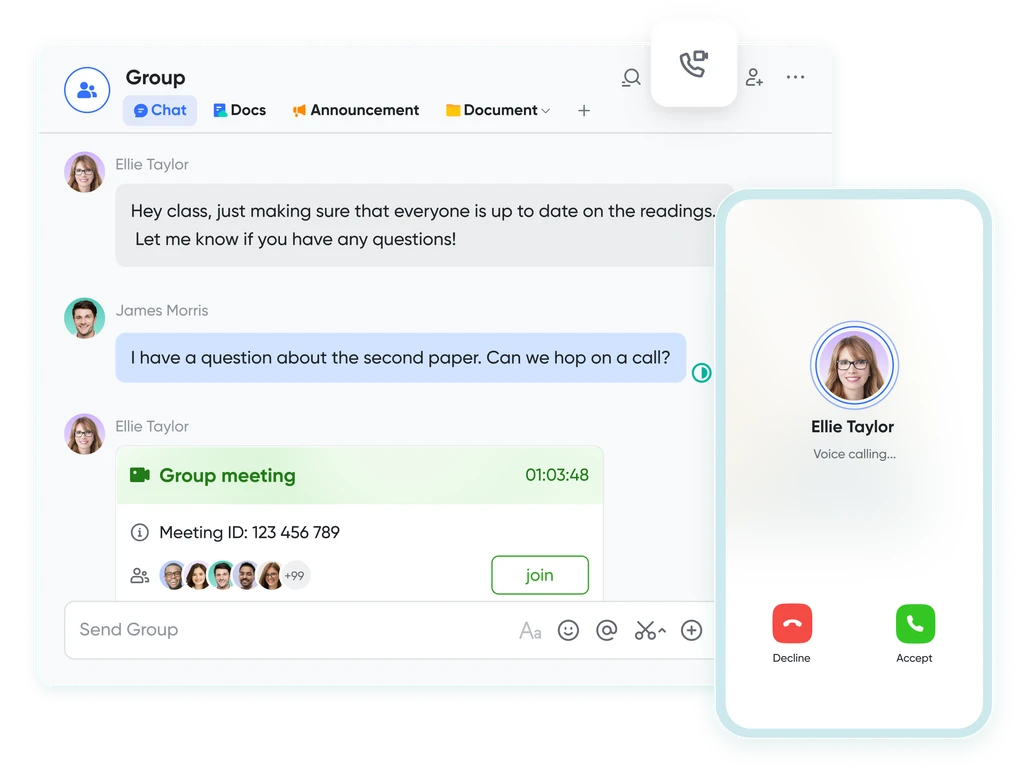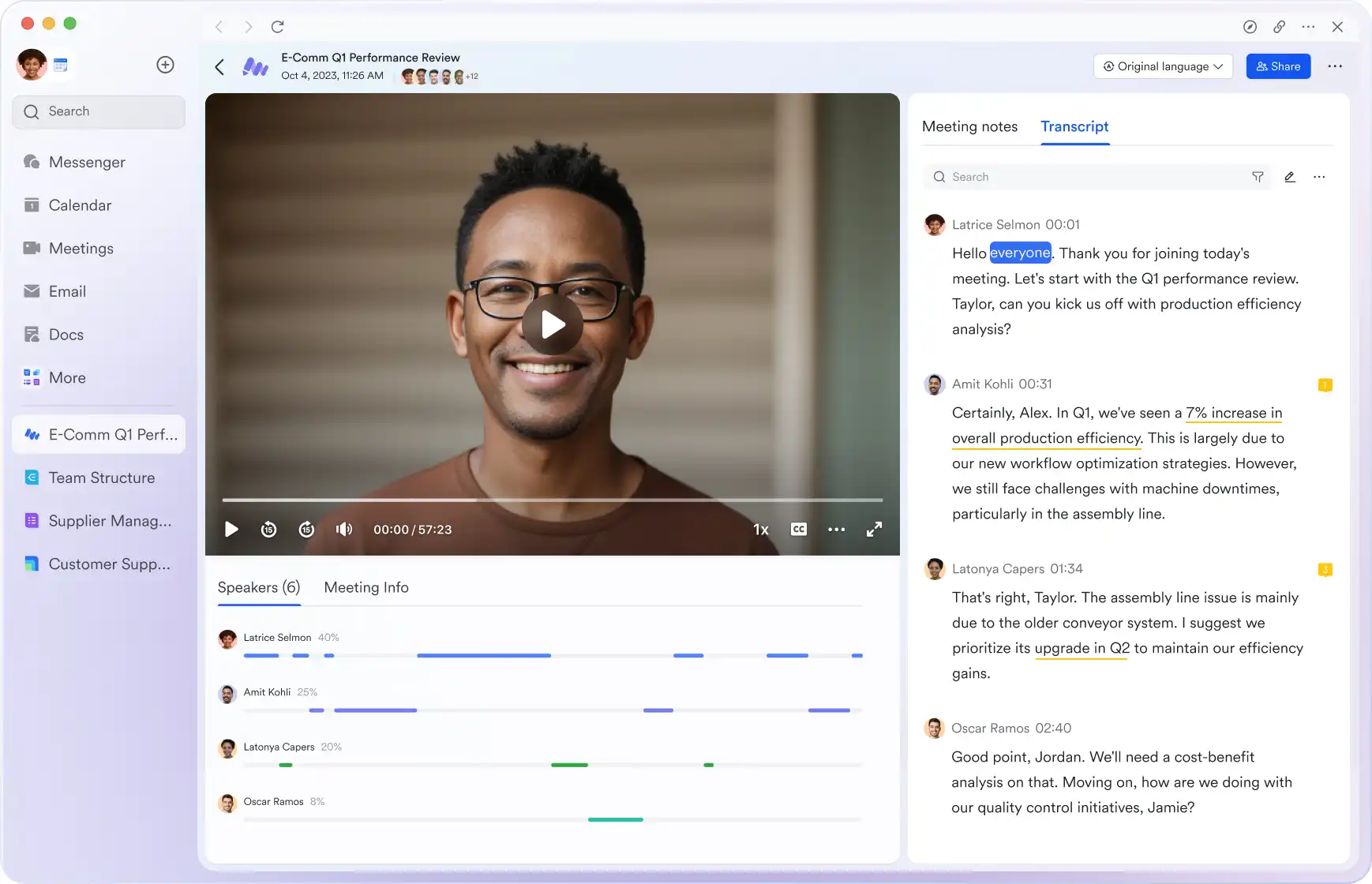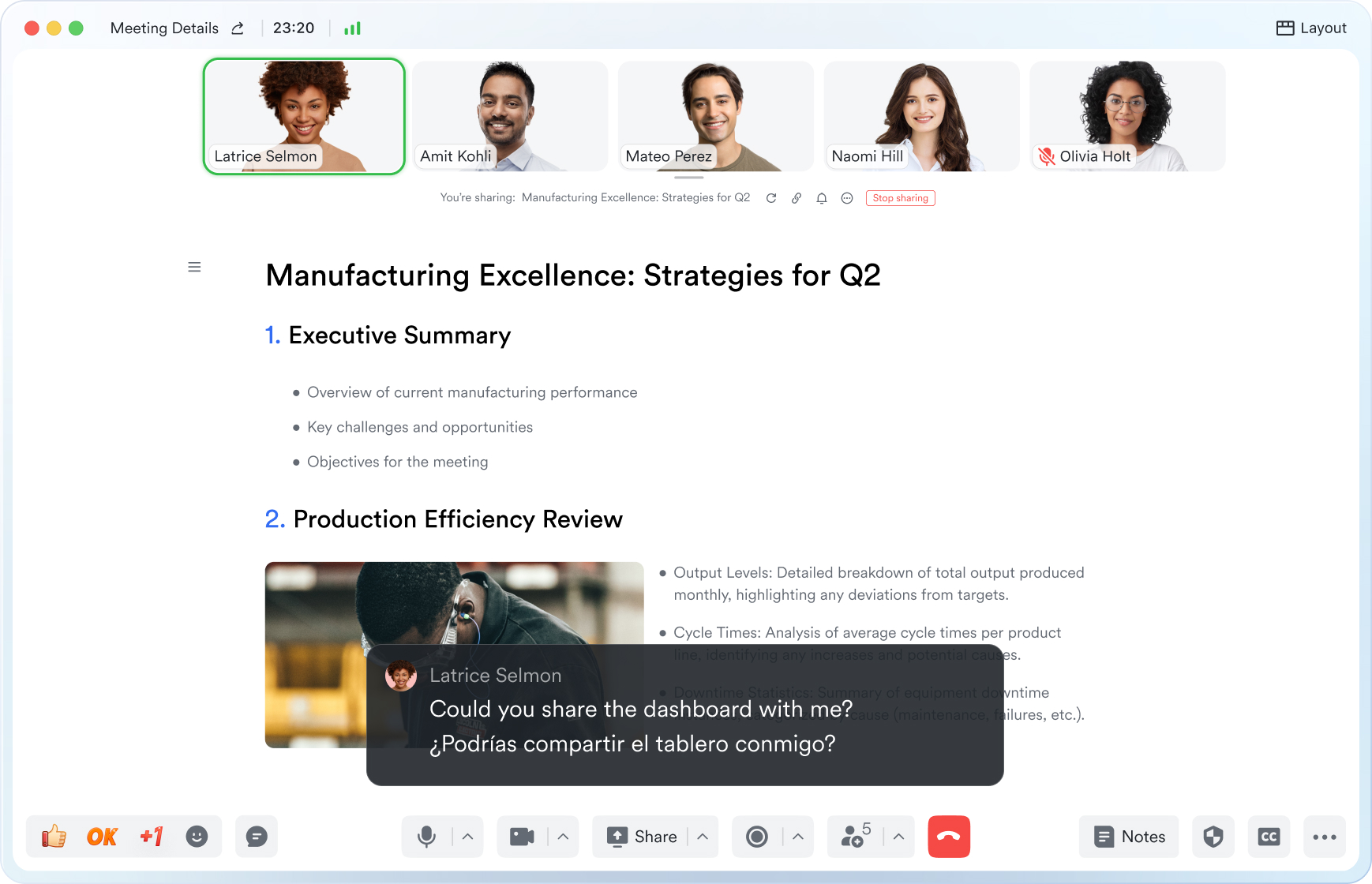Pitch Meeting
This guide will walk you through the essential elements of use pitch meeting to keep your attendees aligned and engaged.
Try Lark for Free
In the vibrant realm of contemporary business, the significance of pitch meetings cannot be overstated. The purpose of this comprehensive guide is to equip professionals with the knowledge, strategies, and actionable insights necessary to navigate and excel in the context of pitch meetings in 2024. By delving into the goals, structure, practical examples, and potential pitfalls of pitch meetings, this guide aims to empower individuals and organizations to harness the power of these crucial business interactions effectively.
Use Lark Meetings to turn meetings into true collaborative experiences.
What is a pitch meeting?
Pitch meetings serve as dynamic forums for presenting ideas, proposals, and business initiatives to key stakeholders, decision-makers, and potential collaborators. These meetings are designed to convey the value, feasibility, and potential impact of a particular concept or project, with the aim of seeking support, approval, or strategic alignment. A successful pitch meeting requires compelling communication, strategic planning, and a thorough understanding of the audience and their expectations.
Goals of pitch meetings
The primary objectives of a pitch meeting revolve around conveying a compelling narrative, articulating clear objectives, and eliciting a positive response from the audience. By setting specific goals such as securing funding, gaining buy-in for a new initiative, or obtaining strategic partnerships, pitch meetings serve as pivotal moments for driving progress and realizing strategic objectives.
Who should attend pitch meetings?
The composition of attendees in a pitch meeting is critical to its success. Key stakeholders, decision-makers, potential collaborators, and subject matter experts are essential participants who bring diverse perspectives and expertise to the table. The presence of individuals with the authority to make decisions and the capacity to contribute meaningfully to the discussions is pivotal for achieving the desired outcomes of the pitch meeting.
Learn more about Lark x Meetings
Topics, agenda, and structure of pitch meetings
Crafting a well-defined agenda that encompasses essential topics, structured discussions, and strategic transitions is fundamental to the effectiveness of a pitch meeting. The structure of the meeting sets the stage for a coherent and engaging presentation of ideas, facilitating meaningful interactions, and allowing for ample time for deliberation and feedback.
Learn more about Lark x Meetings
How often does a pitch meeting occur?
The frequency of pitch meetings varies based on the nature of the initiatives being presented and the pace of business activities. While some organizations may host pitch meetings regularly as part of their innovation or investment processes, others may schedule them based on specific project timelines or strategic milestones.
Key differences between pitch meetings and another similar meeting
Distinguishing pitch meetings from other types of business gatherings is crucial to understanding their unique dynamics. Unlike routine status meetings or general presentations, pitch meetings are centered around seeking specific outcomes, such as securing support, partnership, or resources, often involving higher stakes and more targeted objectives.
Learn more about Lark x Meetings
Three practical examples of pitch meetings
Case study 1: innovative start-up seeking investment
Case study 1: innovative start-up seeking investment
In this scenario, a dynamic and forward-thinking start-up seeks to secure investment for its disruptive technology. The founders meticulously prepare a pitch meeting that showcases their product's potential, market traction, and future growth strategy, ultimately securing the interest of several venture capitalists.
Case study 2: corporate partnership pitch
Case study 2: corporate partnership pitch
A well-established corporation aims to forge a strategic partnership with a complementary industry player. The pitch meeting emphasizes the synergies, mutual benefits, and strategic alignment, leading to a successful collaboration that propels both entities towards shared objectives.
Case study 3: product launch presentation
Case study 3: product launch presentation
In preparation for the launch of a groundbreaking product, a company organizes a pitch meeting to garner internal support and resources. The compelling presentation effectively conveys the product's value proposition, generating enthusiasm and commitment from cross-functional teams, accelerating the launch process.
Common pitfalls of pitch meetings
Despite their potential for driving impactful outcomes, pitch meetings can encounter various challenges and pitfalls. These may include:
- Lack of clarity in presenting the value proposition or project objectives.
- Overwhelming the audience with excessive technical details or information.
- Failing to engage or address the concerns of critical stakeholders, leading to skepticism or disinterest.
Learn more about Lark x Meetings
Dos and don'ts of pitch meetings
A successful pitch meeting hinges on adherence to essential best practices and avoidance of common pitfalls. Consider the following do's and don'ts:
| Do's | Don'ts |
|---|---|
| Clearly articulate the | Overwhelm the audience with |
| value proposition and | excessive details or technical jargon. |
| strategic objectives. | |
| Engage the audience | Rush through the presentation without |
| and invite participation | allowing time for questions or feedback. |
| for meaningful dialogue. | |
| Disregard the specific needs and | |
| concerns of the audience. |
What makes a virtual pitch meeting successful?
In the era of remote work and virtual interactions, hosting successful pitch meetings in a virtual environment requires a nuanced approach. Leveraging technology, optimizing the virtual platform for seamless communication, and ensuring engaging interactions despite physical distances are crucial to the success of virtual pitch meetings.
Learn more about Lark x Meetings
Typical takeaways of pitch meetings
The outcomes of a well-executed pitch meeting extend beyond mere approval or agreement. They include actionable insights, strategic alignment, newfound opportunities, and the tangible progress of projects or initiatives. Additionally, feedback and constructive input from stakeholders and decision-makers serve as valuable takeaways, guiding further refinement and implementation of ideas.
Questions to ask in a pitch meeting
In a pitch meeting, the art of asking strategic and insightful questions can significantly influence the depth and quality of interactions. Consider the following categories of questions to guide productive discussions:
-
Clarifying Questions
- Seek clarity on the objectives, scope, and potential impact of the presented proposal or initiative.
-
Feasibility and Resources
- Inquire about the resources required, potential challenges, and the feasibility of implementation.
-
Strategic Alignment
- Explore synergies, strategic fit, and potential value for the organization and its stakeholders.
-
Anticipating Concerns
- Address potential reservations or concerns, proactively seeking to assuage doubts and clarify ambiguities.
Learn more about Lark x Meetings
Conclusion
In conclusion, this comprehensive guide serves as an invaluable resource for professionals navigating the landscape of pitch meetings in 2024. By understanding the nuances, embracing best practices, and leveraging strategic insights, individuals and organizations can harness the potential of pitch meetings to drive innovation, secure partnerships, and propel their initiatives towards success.
Learn more about Lark x Meetings
Use Lark Meetings to turn meetings into true collaborative experiences.
A Game Changer for Pitch Meeting: Empower your team with Lark Meetings
In the fast-paced and dynamic world of modern business, effective communication and collaboration are crucial for success of Pitch Meeting. Here we introduce Lark Meetings to serve as a centralized hub for all communication needs.
Transform your meetings into collaborative endeavors

Leverage the potency of in-call document sharing, intelligent meeting minutes, and mobile-optimized features to enhance productivity collaboratively, irrespective of your location or schedule.
Seamlessly collaborate in real-time, across any device

Share live documents instead of just screen views. Participants can navigate and edit simultaneously within the video call window, even while on the move.
Shift your focus to engagement, not note-taking

Lark Minutes automatically converts video meetings into transcripts, facilitating easy viewing, searching, and collaborative editing. Stay in the loop asynchronously, even if you can't attend the live meeting. Lark Minutes for meeting minutes support translation into 10+ different languages.
Break language barriers in communication

Lark Meetings provide real-time translation for subtitles, allowing individuals from diverse backgrounds to express themselves in their native languages. Ensure every voice is heard, regardless of geographical location. Live subtitles currently support translations from English, Chinese, and Japanese to 10+ different languages. See more translation feature in Lark.
Connect with larger audiences
Host dynamic online meetings and events accommodating up to 1,000 participants, with the flexibility of up to 50 breakout sessions for intimate group discussions within the larger meeting context. Try more Lark features for free.








